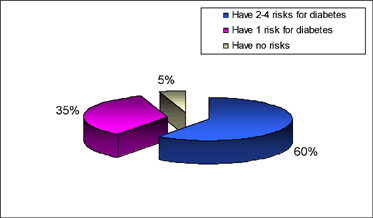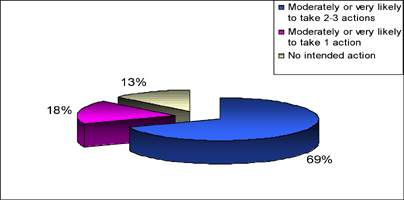October 2007 // Volume 45 // Number 5 // Feature Articles // 5FEA5
Preventing Diabetes: You Have the Power to Take Action
Abstract
This article describes an educational program for preventing diabetes that was designed through collaboration led by Penn State Cooperative Extension. The evaluation revealed that citizens who thought they were at risk for diabetes will come to a prevention program on diabetes, learn among other things, ways to reduce risks, and the symptoms and tests for diabetes. Most participants revealed that as a result of the program, they would take two to three prevention actions within a 3-month period to reduce their risk of diabetes.
Introduction
The prevalence of diabetes continues to increase in epidemic proportions in all races, age groups, and states across the country. Nationally, 20.6 million people (9.6% of the population) have diabetes, which reflects an increase of 2.6 million people (0.7% of the population) in the past 2 years. Of these, 10.9 million (10.5%) men and 9.7 million (8.8%) women over age 20 years and older have diabetes. In the United States, 3.2 million non-Hispanic Blacks (13.3% of this population) and 2.5 million Hispanic/Latino Americans (9.5% of this population) aged 20 years of age or older have diabetes. On average, Mexican Americans, the largest Hispanic/Latino subgroup, are 1.7 times more likely to develop diabetes as compared to those non-Hispanic Whites of similar age (National Institute of Diabetes and Digestive and Kidney Diseases, 2005).
In Pennsylvania, the Department of Health's 2004 Behavioral Risk Factor Surveillance System (PA DOH BRFSS) reveals equally dramatic trends. In Pennsylvania, 6,033 (8%) have been told they have diabetes, a full 1% increase in the past 2 years. In the African-American and Hispanic populations, 483 (9%) have been told they have diabetes during the same time period (PA DOH, 2004).
The risk of diabetes increases with age. Of the people in Pennsylvania with diabetes, 1% were told when they were between the ages of 18 and 29, 3% between the ages of 30 and 44, 10% between the ages of 45 and 64, and 17% were age 65 or older. There is no difference in the incidence of diabetes between men and women aged 18 years or older in Pennsylvania (PA DOH, 2004).
The incidence of diabetes continues to increase. In 1980, 5.8% of the American population was diagnosed with diabetes. This increased to 11.1% in 1999 and to 14.7% in 2005 (a 3.6% increase in 6 years). In the U. S., it is estimated that 54 million people have pre-diabetes, with a fasting blood glucose between 110-125 mg/dl (American Diabetes Association, 2007).
A contributor to the increase in diabetes is the increase in the number of Americans who are overweight and/or obese, and this is reflected in the following statistics. The prevalence of overweight characteristics among youth and obesity among adults, particularly men, increased significantly from 1999-2004. Those between the ages of 2 and 19 saw an increase of 3.2% (13.9% to 17.1%), and those 20 years of age and older saw a 1.7% increase (30.5% to 32.2%) (Ogden, Carroll, Curtin, McDowell, Tabak, & Flegal, 2006). The increased body fat resulting in overweight and obesity is the primary contributing factor to the incidence of diabetes. According to the 2004 PA DOH BRFSS, 37% of Pennsylvanians are overweight and another 24% are obese.
The large number of Americans with diabetes affects quality of life and is an economic burden on those with the disease. Risk of death among people with diabetes is about twice that of people without diabetes of similar age. Adults with diabetes have stroke and heart disease death rates that are two to four times higher than adults without diabetes. Seventy-three percent of adults with diabetes have high blood pressure or use prescription medications for high blood pressure. Fifty percent of all leg and feet amputations are due to diabetes, and 60% of those with diabetes experience nerve damage. In addition, the disease is the leading cause of blindness and end-stage renal disease in the U.S. (NIDDK, 2005).
With 20.8 million people in the U.S. currently afflicted with diabetes at an observed total cost to the U.S. in 2002 of $132 billion (diabetes medical costs are $92 billion and indirect costs, i.e., disability, work loss, premature mortality, are $40 billion), the prevention of this disease is of utmost importance (NIDDK, 2005). These costs are directly related to diabetes and its co-morbidities.
While treatment prevents some of these devastating complications, they cannot usually restore normal blood glucose or eliminate all of the adverse consequences. In 2002, the results of the Diabetes Prevention Program, a 27-center randomized clinical trial of 3,234 people with pre-diabetes, revealed that compared to standard lifestyle changes and placebo, 58% were able to reduce their risk of developing diabetes with intensive lifestyle changes and 31% with standard lifestyle changes along with metformin (a prescription medication). The study's conclusion is that intensive lifestyle interventions of moderating diet and physical activity can prevent or delay the onset of type 2 diabetes among high-risk adults (Diabetes Prevention Program Research Group, 2002).
In 2005, 1.5 million new cases of diabetes were diagnosed in people over 20 years of age (NIDDK, 2005). This number needs to be reduced to decrease complications, health costs, and ultimately deaths. Research in Extension has examined the design and success of programs developed for those with a diagnosis of diabetes (Chapman-Novakofski et al., 2004; Williams, LeBlanc, & Christensen, 2004; Raidl, Spain, Lanting, Lockard, Johnson, Spencer et al., 2007). However, no studies have examined if Extension can design a prevention program that will attract citizens who are at risk for diabetes in order to prevent these people from developing the disease.
The Program in Pennsylvania
To address the diabetes issue, the Preventing Diabetes: You Have the Power educational program was collaboratively developed for Extension educators to use as part of an overall Creating Health initiative, a partnership between Penn State Cooperative Extension and Penn State Public Broadcasting (WPSU) funded by a Penn State Outreach Program Innovation Grant. The purpose of the Creating Health initiative is to convey messages that help people build upon their culture of self-reliance to develop preventative behaviors and improve their health in many health areas. A principal goal is to motivate audiences to engage themselves and their families in healthier lifestyles and behaviors. This initiative responds especially to the needs of many rural Pennsylvanians who are faced with access barriers to health services (Office of Rural Health, 2003).
This program is concentrated on the effects and risk factors of diabetes, the practices to reduce the risk of diabetes, the symptoms of diabetes, and testing procedures to evaluate blood sugar test results. Based on the Stages of Change theory and best practice program delivery strategies well-known in Cooperative Extension, a number of peer reviewed program materials were developed to reinforce key message points. The curriculum materials, which also have the same name as the program, included a:
- PowerPoint visual presentation and script written and pilot tested by an Extension educator who is also a certified diabetes educator (CDE);
- Survey evaluation developed by the CDE, a program evaluator, and two Extension educators;
- Poster exhibit highlighting risk factors, symptoms, and keys for maintaining a healthy weight developed by the Extension educators led by the CDE;
- Resource manual for Extension educators developed by the CDE, and the state program leader; and
- Television documentary on diabetes prevention developed by WPSU with input from the CDE, faculty members, and the state program leader.
At the county level, Extension educators could tune in during a live broadcast or use the documentary as a videocassette or DVD at a later time. The documentary featured personal vignettes of people who are working to prevent diabetes as well as those who have the disease. The documentary provided guidance to participants on incorporating nutrition and physical activity recommendations into their life.
The program was advertised and presented to community audiences, including civic and women's groups, teachers, senior citizens, college students, home health caregivers, human service employees, and the general public. From October 2002 though November 2003, over 900 citizens enrolled in Preventing Diabetes: You Have the Power. Additionally, WPSU scheduled the program 25 times for public television audiences.
Since the Diabetes Prevention Program found that with intensive lifestyle training along with at least a 7% reduction in weight, those who were at high risk of developing Type 2 diabetes can reduce their risk by 58% within 3 years (Diabetes Prevention Program Research Group, 2002). We based our intervention, Preventing Diabetes: You Have the Power program, on the same principles and included information on a variety of dietary issues, such as dining out, label reading, and evaluating one's current eating plan--all of which helped to empower participants with realistic and practical strategies to make lifestyle changes to help them reduce their risk of developing diabetes. Community partners such as the American Diabetes Association, offices on aging, senior citizens centers, and the Pennsylvania Department of Health and Certified Diabetes Educators assisted with the program.
Evaluation Methods
The evaluation was designed to measure if the program (1) reached citizens at risk and (2) led to an impact on participants with respect to learning and lifestyle behaviors. The evaluation consisted of an end of program survey in booklet form with 10 questions. Twenty-seven counties participated. See Figure 1.
Figure 1.
Pennsylvania Counties That
Participated in the Preventing Diabetes: You Have the Power Program

Measures to evaluate whether the program reached citizens at risk for diabetes included questions asking whether a doctor or health care professional told them they had diabetes; whether they have a family history of diabetes; and what demographic characteristics they had (to determine the extent to which they were at risk for diabetes). A question to evaluate whether the program reached an additional important audience asked whether the respondent provided any type of assistance or support for someone with diabetes.
Measures to evaluate initial impact included two basic questions. The first asked the respondent the extent to which they learned five fundamental concepts about diabetes including side effects, risk factors, what to do to reduce risk, symptoms, and testing. The second asked respondents the extent to which they intended to take three preventive behaviors within the next 3 months. The behaviors included having glucose tested and changing eating and physical activity habits to reduce the risk of diabetes.
A follow-up question, designed to validate a part of the second question on intention to change eating habits, asked respondents to specify two diet changes they intended to make within the following 3 months.
Eight hundred and ninety-three program participants across Pennsylvania completed the evaluation. Although the results reflect the 522 participants who were asked to sign consent forms and for whom we can report the results, we found no significant differences between the participants who signed the consent forms (N=522) and those who did not (N=377) on all measures. Thus, the results reflect the impact on approximately 900 people statewide.
Evaluation Findings
The findings revealed if the program (1) reached people at risk and (2) led to an impact on the participants' learning and lifestyle behaviors.
Who Participated in the Preventing Diabetes: You Have the Power Program?
The program attracted the appropriate target audience--people at risk for diabetes. The risk factors included a family history of diabetes; overweight or obese state as assessed by the participants through a class activity; 45 years of age and older; of African American, Hispanic, Asian American, Pacific Islander, and/or Native American descent; and diagnosed with diabetes when pregnant. Almost all of the participants (95%) had at least one risk factor, and a majority (60%) had two to four risk factors for diabetes. See Figure 2.
Figure 2.
Summary of Risks That
Participants Had for Diabetes. (N=522)

The program attracted another appropriate target audience--those who provided assistance or support for someone with diabetes. Forty-three percent of the participants indicated they had cared for a person with diabetes in the past year (N=496).
Educational Impacts
In terms of learning about the prevention of diabetes (the effects, risk factors, ways to reduce risk, symptoms, and testing), about half the participants (46%-55%) indicated they learned a "moderate amount" or "a great deal" about each topic (N=476-495).
Most participants indicated they were "moderately" or "very likely" to take two or three actions within three months to reduce the risk of diabetes. See Table 1.
| Preventive Actions | Percent Responding Moderately or Very Likely |
| Have your glucose tested (N=464) | 71 |
| Change your physical activity habits to reduce your risk of diabetes (N=480) | 71 |
| Change your eating habits to reduce your risk of diabetes (N=486) | 68 |
Looking at the same data across all actions, instead of action by action, we can observe the impact on the individual participant in terms of the number of actions each individual planned to take. See Figure 3.
Figure 3.
Percent of Participants Who Are
Likely to Take 0-3 Actions to Prevent Diabetes Within 3 Months.
(N=490)

When participants were asked to be more specific and indicate other changes they would make in their diet, thus validating the data in Figure 3, more than one-third of the participants (36%) listed two intended diet changes, and the other two-thirds (63%) indicated they would make one change in their diet (N=364). Changes fell into 13 categories, from lowering portion sizes and adding fruits, vegetables, and foods with fiber, to reducing the amount of other foods like meat and snacks and those with sugar and fat.
Implications and Conclusion
The study reported here investigated the degree to which the program reached individuals at risk for diabetes and the impact of the prevention program on those citizens. Extension educators were effective in attracting a high number of program participants with risk factors for diabetes as well as caregivers. Participants learned about the causes and effects of diabetes. And an even greater percentage indicated their likelihood of adopting up to three specific actions recommended by the educators to prevent diabetes, as well as other preventive actions within the following 3 months.
Many important implications for Extension emerge from the evaluation findings for this new program.
- Citizens with risks for diabetes will attend an Extension program on preventing diabetes, that is, before the disease takes effect. This finding has health, social, and financial benefits for the participants and society in general.
- The program can reach an unexpected, new audience. With 43% of the audience being caregivers, Extension created an opportunity to provide diabetes education to caregivers.
- Using community settings, Extension is able to provide education through a variety of methods to help citizens understand the etiology of the disease, other issues surrounding the diagnosis of diabetes, and lifestyle changes that can help to reduce one's risk of developing diabetes.
- However successful, this prevention program needs to expand its marketing in the future to citizens only minimally represented in the program the first year to more men, citizens between 40 and 60 years of age, and Hispanics and African-Americans (groups at greater risk for the disease).
- When Extension educators are involved, the program can become more established in the organization and can have a higher level of visibility and credibility within the organization (Chapman-Novakofski et al., 2004).
- State program leaders can be influential in bringing public television, a program evaluator, and Extension educators from across counties together to create and conduct a prevention program, resulting in more continuity in programming within Extension and widespread impact across a large geographical area. Collaboration for Extension appears to be a key in preventive health (Litchfield, Muldoon, Week, Hallihan, & Lane, 2005). When a state program leader integrates a statewide evaluation of a new program, it can provide validation of a program and determine where the program can be improved or expanded, i.e., to other audiences.
A prevention program like this one can be part of lifestyle changes needed to aid in the prevention of diabetes. A reduction in diabetes can lead to a healthier society, reduced health care costs, and enhanced quality of life.
References
American Diabetes Association, Pre-diabetes. (2007). Available at: http://www.diabetes.org/pre-diabetes.jsp
Center for Disease Control, National Diabetes Surveillance System: Incidence of diabetes (2005). Available at: http://www.cdc.gov/diabetes/statistics/index.htm
Chapman-Novakofski, K., DeBruine, V., Derrick, B., Karduck, J., Todd, J., & Todd, S. (2004). Using evaluation to guide program content: Diabetes education. Journal of Extension [On-line], 42(3). Available at: http://www.joe.org/joe/2004june/iw1.shtml
Diabetes Prevention Program Research Group. (2002). Reduction in the incidence of type 2 diabetes with lifestyle intervention of metformin. New England Journal of Medicine 346(6):393-403.
Litchfield, R. E., Muldoon, J., Welk, G., Hallihan, J., & Lane, T. (2005). Lighten up Iowa: An interdisciplinary, collaborative health promotion campaign. Journal of Extension [On-line], 43(2) Article 2FEA6. Available at: http://www.joe.org/joe/2005april/a6.shtml
National Diabetes Information Clearinghouse (NDIC). (2005). National diabetes statistics [On-line]. Available at: http://diabetes.niddk.nih.gov/dm/pubs/statistics/index.htm
Office of Rural Health. (2003). The Pennsylvania rural hospital flexibility program/critical access hospital program [On-line]. Available at: http://porh.cas.psu.edu/cah
Ogden, C., Carroll, M., Curtin, L., McDowell, M., Tabak, C., & Flegal, K. (2006). Prevalence of overweight and obesity in the United States, 1999-2004. Journal of the American Medical Association, 295(13).
Pennsylvania Department of Health BRFSS. (2004). 2004 behavioral health risks of Pennsylvania adults [On-line]. Available at: http://app2.health.state.pa.us/epiqms/Asp/SelectParams_BRFSS_Tbl_State.asp
Raidl, M., Spain, K., Lanting, R., Lockard, M., Johnson, S., Spencer, M., et al. (2007). The healthy diabetes plate. Preventing chronic disease. [Serial On-line]. Available at: http://www.cdc.gov/search.do?queryText=preventing+chronic+diabetes&searchButton.x=12&searchButton.y=14&action=search
Williams, D. P., LeBlanc, H., & Christensen, N. K. (2004). Diabetes stepping up to the plate: An education curriculum focused on food portioning skills. Journal of Extension [On-line], 42(3). http://www.joe.org/joe/2004june/rb7.shtml
